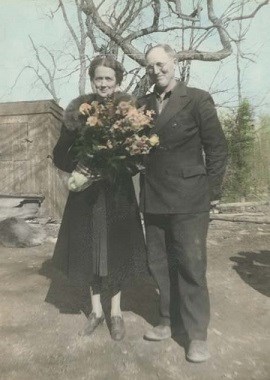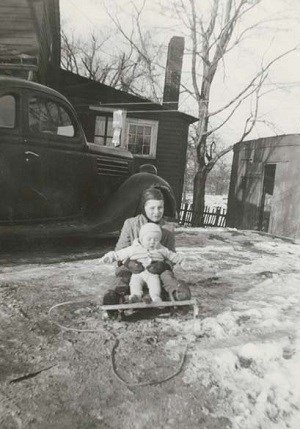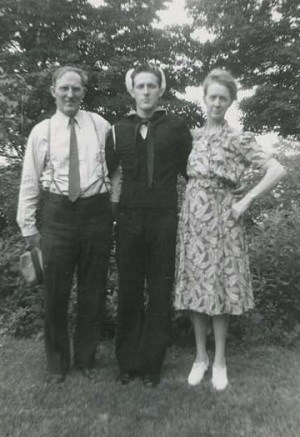Last updated: April 13, 2022
Article
The Importance of the Bass Family to Life on Weir Farm
By Dr. Darla Shaw, Volunteer Researcher
There were many people that worked the land during the time that Julian Alden Weir and his family lived on Weir Farm. Each left their mark, but none more than the Bass Family that worked the farm for 15 years between 1929 and 1944. During their time on the farm, George and Bessie Bass raised all nine children and will always be remembered along with Joe Knoche, their stonewall building neighbor.

National Park Service, Weir Farm National Historical Park, Wilton, CT. Bass Family Photograph Collection, HP1029.
Historical records show that the early Bass families came from England and Scotland, immigrating here to work in the textile mills of Eastern CT.
No one is exactly sure how the Bass Family got from Windham in Eastern Connecticut to Weir Farm, but there is evidence of J. Alden Weir’s first wife, Anna Dwight Baker, having land in Windham. Dorothy Weir Young also had property in Windham. Both Ridgefield/Wilton and Windham were beautiful farm communities with great opportunities for painting. Being an extremely hard worker, George Bass was often offered jobs.
When the Bass family moved into the Weir Caretaker’s Cottage, now housing for artists in residence, the parents came with seven children, and a grandmother. Later on two more children would be born and a nephew from Windham would often live with the family. The Bass Family was a strong, loving family unit. They were very dedicated to Dorothy Weir Young and her husband, Mahonri. It was not unusual for George to work seven days a week and take no vacations. Even when George lost several fingers while chopping wood, he took off no time and made his own brace so he could continue working. In the beginning George was making $65.00 a week with housing and farm produce included. Later on his pay went up to $85.00 a week. His older son, Mervin made a slightly lower salary and continually worked alongside of his father. The Bass family took pride in their work on the farm.
Since Weir Farm was an actual working farm, the younger boys were responsible for taking care of the farm animals, collecting eggs and maple syrup, racking leaves, watering, weeding and doing their part. Animals on the farm included a bull, horses, cows, chickens, peacocks, squabs, dove cotes, guinea hens, ducks, rabbits, and pigs. The boys liked to trap small animals and collect road kill to sell to the local trapper in Branchville. There was little tree cutting on the farm as both George and Dorothy agreed that the land was so beautiful it must not be destroyed by taking down trees for the sake of growing more crops.

National Park Service, Weir Farm National Historical Park, Wilton, CT. Bass Family Photograph Collection, HP1028.
Since there were not many houses nearby, the Bass children played mostly with each other. Since they had no money for toys, the children made their own toys and came up with their own games. The Young family had a trap shooting facility for guests. After the boys worked the clay pigeons for others, they were able to shoot as well. The most fun for the boys was throwing their dirty clothing from the second floor to the first and then taking one big jump into the pile of clothing. Fortunately, no one ever got hurt. The children loved floating in the Weir pond on logs and hoping they would not get infected with leaches. In the winter they enjoyed sledding down the hill to the old foundation at the intersection of Nod Hill and Old Branchville Rd.
The favorite holiday for the Bass family was the Fourth of July as it was also their mother, Bessie’s birthday. They celebrated with great food and by putting fireworks down the drain pipes and visiting relatives from Windham.
Like with any farm life, there were tragedies. There were fires due to clogged chimneys, out of control brush burning, and lightning strikes. Animals died due to age and accidents. There were years when the crops were poor due to weather conditions.

National Park Service, Weir Farm National Historical Park, Wilton, CT. Bass Family Photograph Collection, HP 1009.
The Bass children went to small school houses; Wilton Center School and Gilbert and Bennett School. When it came to high school they transferred to Westport or Ridgefield. Bessie was the only child to go to church. She loved to sing in the choir. Since young Bessie had no girls to play with, she spent most of her time helping her mother cook, clean and iron and wash the boys’ clothing.
Like her father, Dorothy Young was a very accomplished painter. She often used the Bass family as models. In some of Dorothy’s art collections, that are housed in Salt Lake City, Utah, are paintings of Clifford, Eddie, Young Bessie, and Mary Bass, who was married to Mervin Bass. Dorothy’s husband, Mahonri Young, a famous sculptor, used George Bass Sr. and his son Mervin as models for a famous sculpture called This Is the Place.
As soon as most of the boys in the family reached the age when they were able to enlist in the military, they did so. Eddie, the third eldest son, lost his life during World War II when the S.S. Juneau went down with the Sullivan Brothers. His funeral was held at the Wilton Congregational Church and his family was paid $10,000 by the government for his loss. This money was used by the family to invest in a large farm on Barnum Road in Danbury. Here George and Bessie lived in the main house and the brothers and sisters would each receive land on which to build. All of the brothers would then help each other build individual houses on their land.
As of 2020, only two of the Bass brothers are still alive. Charlie lives in Southington, CT, and Kenny lives on the original Danbury farm. Their parents were married for 74 years and showed their children and their many decedents how to live a successful life. Today the males still go into the military, everyone loves to work the land and has a garden, and working with one’s hands is considered an art.
